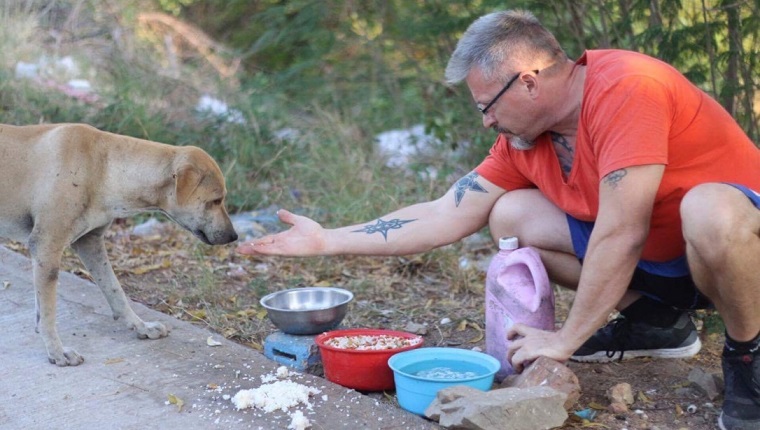One of my favorite things about being a writer for DogTime is the opportunity to meet incredible people who’ve changed dogs’ lives for the better. Michael is certainly one of those people. He’s known by many as “The Man That Rescues Dogs,” and there’s a good reason for that. He and his staff care for almost 1,000 dogs at their rescue in Thailand!
I first started following Michael when I happened upon a video on Facebook that had me streaming happy tears. I knew then that I just had to meet the man behind this wonderful rescue in Thailand! You can watch the video that first let me know about the amazing work he was doing below.
Michael was gracious enough to take time from his busy schedule for an interview. You can watch our full conversation in the video at the top of this article, and keep reading below for highlights and more info on how to keep up with all the work that “The Man That Rescues Dogs” is doing.
How Did ‘The Man That Rescues Dogs’ Begin?
AMANDA: I am blown away by what you do and honored to meet you, and I feel guilty taking any of your time because you’re taking care of nearly 1,000 dogs, and I’m sure you need every second you can get!
MICHAEL: Well, actually, I think part of my job is to take time to do these types of interviews and give more awareness about what we are doing. And I like it!
AMANDA: Great! My first question for you is — how did this all start?
MICHAEL: I moved to Thailand around 20 years ago, because I wanted a big life change, so I moved from Sweden to Thailand. I’m a chef, and I took care of a few restaurants. Stray dogs are part of the culture here — there are lots of them — and I didn’t take much notice of them — until one day, behind my restaurant, in 2011, there was a dog who showed up in really bad shape.
So, I started to feed her, and she came back every day at 5:00. I gained her trust and was able to take her to the vet.
After that, I started to get involved with a local organization where I lived at the time, and that’s how it started — one dog ten years ago, and now I have 950 dogs and 30 staff.
MICHAEL: Actually, I did this daily, feed the stray dogs, until a clip went viral in 2016 on social media around the world. There was a platform called Newsner, from Sweden, and they did a little clip about me feeding the dogs. That was seen by about 100 million people in one month, and it got translated to many languages.
In May 2016, I decided to rent a house, hire staff, and take in more dogs. Then, I took over the local dog pound in the municipality’s area, and we expanded. And here we are today!
So that was the starting point. That is the power of social media; it can either make or break something!
From A Bowl Behind The Restaurant To Taking Over The Dog Pound
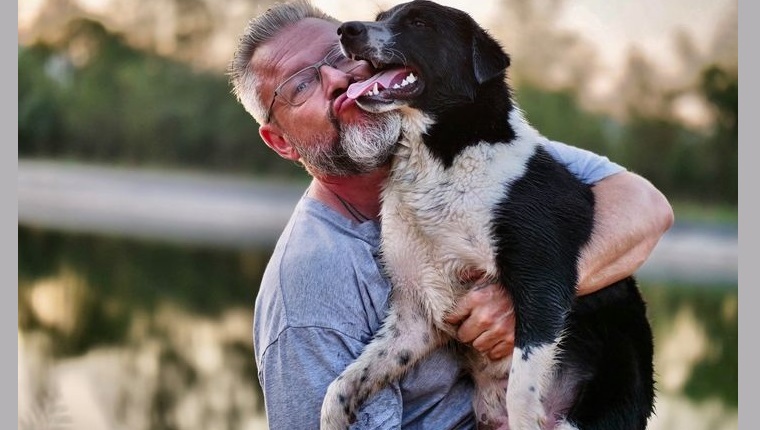
AMANDA: You took over the local dog pound? What a huge responsibility!
MICHAEL: For the municipality I work with, the mayor has been a really good friend of mine for 17 years. He’s a dog lover, which I’m really thankful for because, most of the time, the municipalities don’t work together with dog rescuers or feeders. They’re fighting with them most of the time and say, “Don’t feed the dogs here.” So we’re lucky.
This dog pound was very small, 150 square meters with 100 dogs. I talked to the mayor and said, “I’m going to take this over; I’m going to expand it.” He said, “Okay.”
So we work really closely with them, and I’m lucky and I’m happy. And really, they are happy, too.
AMANDA: It’s amazing to me that you moved from a foreign country to be a chef, and then you decided to change the world there. You changed everything for these dogs!
MICHAEL: I’ve been a chef since I was 18, so I am a chef by profession, dog rescuer by choice. Now, I’m a rescuer full time.
I closed my restaurant three years ago. It was a good place — I had two seatings every night, and it was really popular. I couldn’t do both, though, because in 2016, I had a stroke that was stress-related. I didn’t want to have that again, so I decided between feeding dogs and feeding people.
AMANDA: Oh, I’m sorry. Well, you did not choose a low-stress life, but I think it must be incredibly rewarding!
MICHAEL: It is rewarding. It is.
A Unique Location For A Rescue
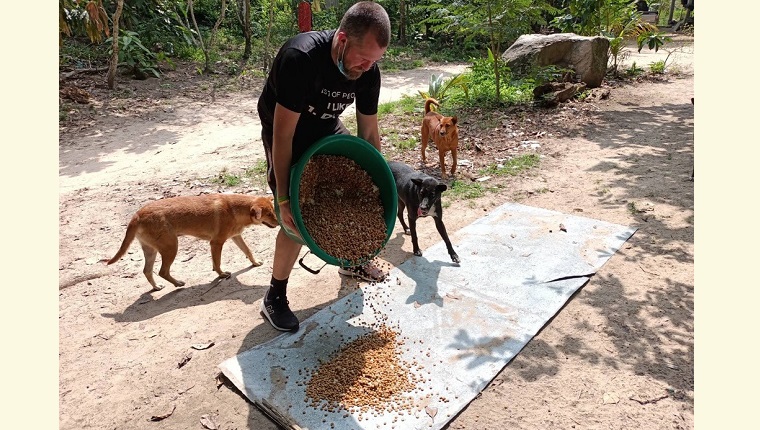
AMANDA: There are so many cool things about what you do; one of them is the location. I wonder if it’s unique to the climate that it’s able to be all outdoors. I think that because it’s so large where you are, that’s why you’re able to accommodate so many dogs.
MICHAEL: Yes, it is large. We do have 600 dogs in the shelter, and we have 350 dogs on the streets that we monitor and feed daily because, in some cases, the dogs are fine where they are, and we don’t need to remove them.
We remove them if they’re in danger, and by danger, I mean people and traffic — so we remove them from the dangerous people. I’m not saying that all people are dangerous, but it only takes one idiot to mess things up. But if they’re safe, then we leave them — we cannot take in all dogs.
We are expanding another 5,000 meters. We have 5,000 square meters now, so then we’ll have 10,000 square meters.

AMANDA: Wow! And can you describe where you are? You said you’re in Thailand, correct?
MICHAEL: We are in Thailand, yes, and we are located one hour from Bangkok, in the middle of the forest. We are located in the municipality’s waste area; it’s a garbage area. So it’s me, dogs, and garbage, which is fine!
AMANDA: How are you able to keep that all up — to maintain it, to keep the dogs safe and such?
MICHAEL: Well, our area is fenced in; we are just located in the area where the municipality designates it as a garbage area. It’s a big area. Yeah, there’s garbage there, but it’s not smelly.
The great thing is no one will want to develop there. There will be no condominiums or anything, which is fine. That means dogs can bark and do whatever they want to do.
AMANDA: What a perfect location! Is your shelter entirely outdoors?
MICHAEL: Yes, it is all outdoor.
AMANDA: I think you have a good climate for that!
MICHAEL: It is! We have a rooves and elevated floors for the rainy season. It’s not cold. It can creep down to 15 degrees Celsius sometimes in January, which can be a little cold for the dogs, since they’re used to 30. It’s chilly for me, too, because we don’t have radiators here.
Caring For The Shelter’s Dogs With Special Needs
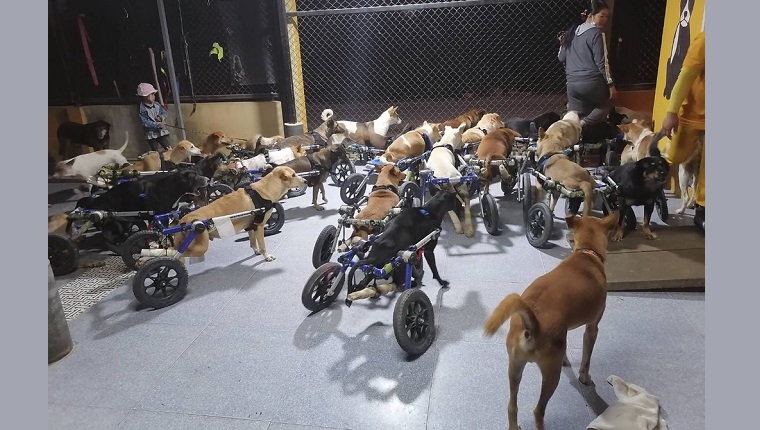
AMANDA: I cried through the entire video I watched about your shelter, but what really got to me was all of the dogs with special needs that you take care of. It’s amazing that you’re caring for almost 1,000 dogs, yet you still manage to provide rehabilitation for many dogs who need it. How are you able to assess the dogs’ medical needs and get wheelchairs? How are you able to do all that?
MICHAEL: We have 29 dogs who need wheelchairs. We’ve been rescuing them since 2016. I, myself, have a dog named Cork, and he’s been with me since 2012. He was actually living next door, and he got run over by a motorbike when he was 9 months old. I suggested to the owner to get a wheelchair. She said she couldn’t take care of him, so I adopted him.
For me, having a handicap dog is not a big deal. The only things you need to do are empty the bladder four times a day and put them in a wheelchair when they’re walking. Otherwise, he’s a dog who barks, messes around, just like a normal dog.
In the care unit, we have these dogs in wheelchairs, a few dogs who are blind, older dogs, and a few dogs who have distemper that has entered their central nervous system — about ten of those.
MICHAEL: We do have two full-time veterinarians in my foundation. We also have a free-of-charge healthcare clinic for anyone who wants to visit us. That’s a no-brainer [to have the two vets on-staff]. There’s always something to do for them. We have 600 dogs in the shelter. If I had to drive to a clinic outside, that would be double the cost, time-consuming, and so on.
In the care unit, it’s not like the dogs are sick all the time. They may be blind, old, or have distemper, but it’s not that we have to care for them as if they’re sick.
AMANDA: I love that attitude, and I think that’s an important message, not just for people who run rescues, but also any people who may have a dog with a disability; that just because they have a disability, it doesn’t mean it’s a full-time job to take care of them, that they can still be a happy dog with a little extra help.
MICHAEL. Yes. We walk them twice a day, at 6 AM and at 2 PM, and it of course takes a little time to put all the dogs in their wheelchairs — about ten minutes. But when they open the gates and the dogs run out, they just take off running. They’re not dreading having to walk again; they are joyfully sprinting.
Getting Wheelchairs For The Dogs Who Need Them
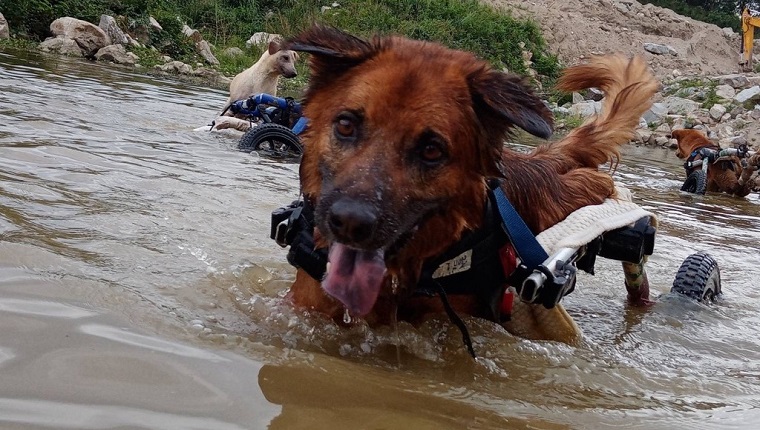
AMANDA: Can you tell me a little about how you find the wheelchairs and design them? Is that something your staff puts together?
MICHAEL: We use a US company called Handicapped Pets. They’re really good wheelchairs and affordable–about $400 USD. They’re really good, and it’s easy to use them. Our dogs are very active, running around in the forest and water, and they also swim in the wheelchairs.
AMANDA: It’s so great to know that resource, and it’s so cool you can just go online and order them.
MICHAEL: Yes. They ship them all over the world, too.
How Did The ‘Wheelchair Mafia’ Come To Be?
AMANDA: I wanted to ask you: where did the name “Wheelchair Mafia” come from?
MICHAEL: From me! I don’t know, they’re a group, a gang, and they run around together, so that’s where I got the name idea!
AMANDA: Cute!
Are The Dogs At TMTRD Available For Adoption?
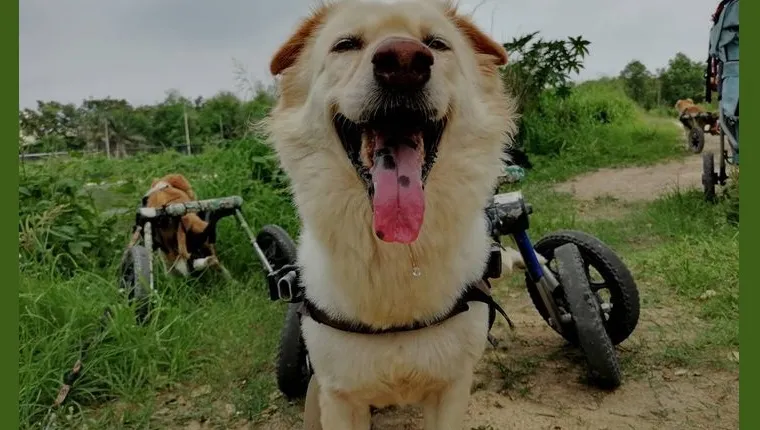
AMANDA: The dogs that you care for, are they available for adoption or foster, or are they lifetime residents?
MICHAEL: We advise people to adopt locally, wherever you are in the world, and we rehome locally — except the Wheelchair Mafia, because [in general] no one here wants a paralyzed dog. They want a “perfect” dog.
So if someone is interested in a member of the Wheelchair Mafia, we will send them abroad. They have a good life here, but they could maybe have a better life in a home.
In general, though, when people inquire about adopting one of our dogs from far away, I advise them to adopt locally. There are so many dogs in shelters all around the world, it just doesn’t make sense to fly a dog all the way from Thailand to another country.
I mean, I could probably rehome all of these dogs, but then you have hundreds of dogs sitting in shelters elsewhere. So, adopting locally makes sense. We do have adoptable dogs on our website for local residents.
AMANDA: That’s a great point. And I think the dogs who live at your shelter live in a doggy paradise, anyway. They get to run around with all your friends, be outside whenever they want, et cetera.
Advice For Others Wanting To Start A Rescue?
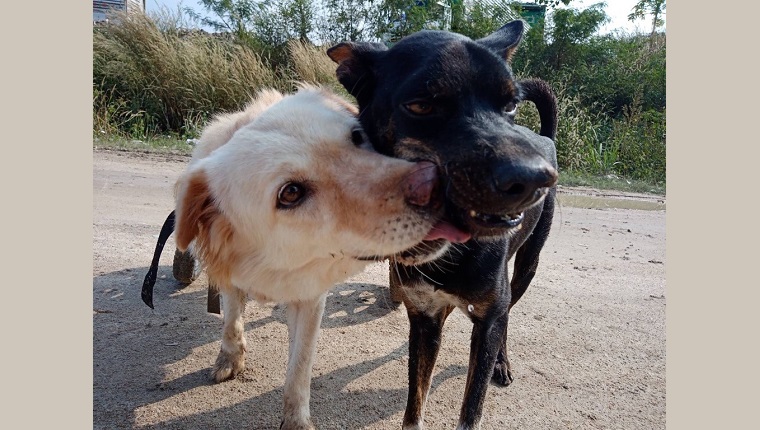
AMANDA: What advice would you give someone who was thinking to start a dog rescue, and especially one that helped dogs with special needs?
MICHAEL: Don’t do it. *laughs* If you want to change your life completely, meaning — close your restaurant, staying single, work 14 hours a day, no days off for 9 years, yes, by all means, do it.
If you do have the intention to change your life that drastically, I would say do not take in more dogs than you can afford, and have a back-up plan if something happens.
Most of the time, people get overwhelmed, starting with the idea of, “I want to change the world!” You cannot do that. As I said, I started ten years ago with one dog, and maybe every year, we add about another 100 dogs and more staff.
You need to think of it as a business, too. It’s not harsh to say that — maybe it sounds that way, but if I don’t think like a business, maybe I would need to close down in six months, and then you would hate me even more.
So, what’s the product? Well, we want to have healthy and happy dogs in a safe and clean environment with staff that take care of them daily. To get there, I need your help, so I’m going to present my idea, my business, to you, and hopefully you say, “That’s nice, I’m going to support this.”
I love dogs; I wouldn’t do this otherwise. This is my calling; I have to do this. But if you cannot make sure you have donations, then you’re not the right person in that position, and you should hand it over to someone who understands business.
There’s nothing wrong with that. You need to treat it as a business, otherwise, you go under, and then the dogs would suffer. I do think that’s the key to success.
Where Does Funding For TMTRD Come From?
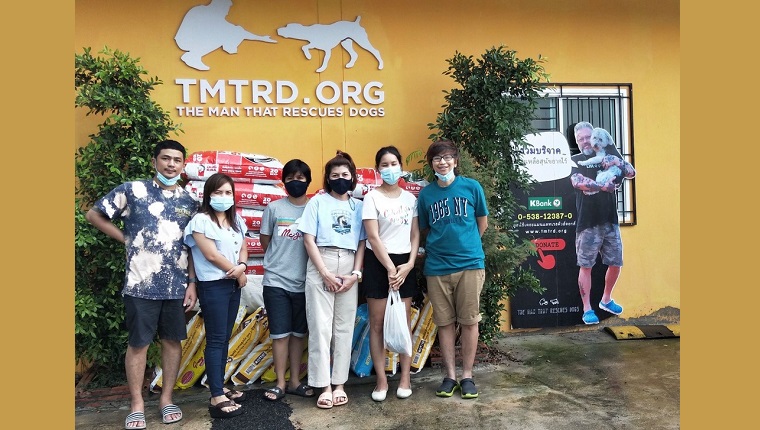
AMANDA: How do you guys do what you do? Is it donations from the government or private donations from people or companies?
MICHAEL: I would say 95+ percent are from private donations. But the bigger you get, the more exposure you get in media, the more companies want to support you in a CSR [Corporate Social Responsibility] program, the more that can vary. Some companies with CSR programs here in Thailand support us with dog food, donation boxes, and other things.
So that’s my job, to make sure you guys donate! During COVID, we’ve seen a loss of 40 percent in donations. What many places are doing is cutting down on cost, letting people go, which may mean facilities are less clean. I didn’t do that; I actually hired a few more staff to make sure donors’ money is coming our way.
Let’s say an average person may have ten organizations they support, but after COVID, they can only support two. It’s my job to make sure our rescue is one of them.
We have a Facebook page and post about five times a day. If every post is showing dogs who are miserable with wounds, people get bored, and I think that goes for most foundations, too. So you need to have a mix of happy pictures, meet the staff, here’s a corporate sponsor — and here, we have an injured dog.
Some people can’t stand to see that at all. They just want to see “cutepuppies.com,” and then I have to tell them to go there, because that’s not what we are. It’s a reality for us. But I cannot post that all the time; you need to have a balance.
With social media, I’ve been doing Facebook for a long time, but I always sign up for the free seminars they offer about page management or advertising because I always learn something. It’s very important to understand this, knowing how not to overdo something, but to spend money where it’s needed, like boosting a post.
When people say, “But people know who you are — why advertise?” I say, “Yes, but look at Coca-Cola. Everyone knows who they are, but they still advertise. They don’t want you to forget about them. So I advertise so people remember who we are, what we’re doing, and say, ‘Here, have ten bucks.'”
AMANDA: That makes total sense.
Who Are The TMTRD Staff?
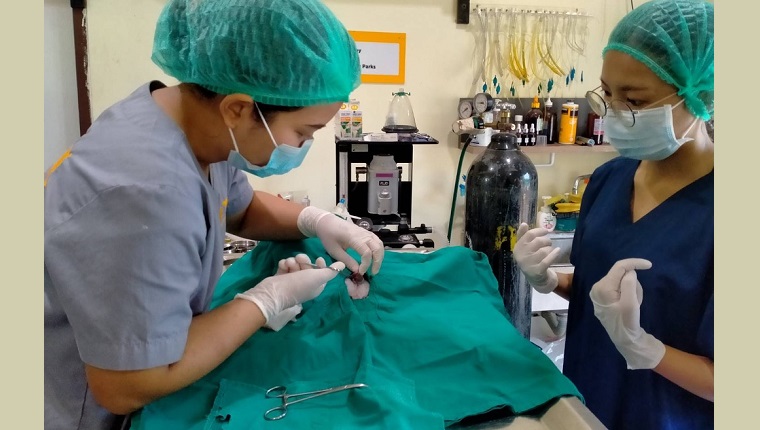
AMANDA: I almost can’t wrap my head around caring for so many dogs. Can you tell us a little bit about your staff? Is everyone paid, or are they all volunteers?
MICHAEL: We have 29 staff now, including me. A guy named Chris volunteered for several months, went to work somewhere for awhile, and then came back a year and a half ago to work here.
We pay all of our staff, including me. I need to eat. I need to live. I’m only 53 years old, and I’m not a millionaire, and with this little hobby, I will never be a millionaire! But no, all staff get paid.
We have two veterinarians — we also have three admins that answer messages, do rehoming interviews, do translations, look for exhibitions, and also H.R. We have two construction guys who do maintenance, fixing, expanding — there’s always something to do for them. And the rest are caretakers.
In Thailand, we work six days a week, with one day off. I work seven days a week. Our staff in the shelter works 7:00 to 4:00. In the care unit, they wake at 5:00 and go for a walk with the dogs.
Then there’s cleaning, laundry, hydrotherapy. Hydrotherapy is so good to get the dogs with mobility challenges moving because otherwise they get frustrated. We have visitors, too, who come to donate and visit the dogs, to see for themselves what they might’ve seen in our videos.
The day goes till about 4:00 or 5:00, and then we take the evening.
The shelter dogs are in the shelter at all times, and the dogs in the care unit stay in that unit, with about 15 staff who sleep in there and stay with them at all times.
We do have some volunteers who come sometimes, but I do not depend on them because sometimes volunteers show up, and sometimes they don’t.
Balancing Life As A Dog Dad And A Rescue Operator
AMANDA: How do you balance life as a dog dad of 18 dogs of your own, as well as these 950 other dogs you care for?
MICHAEL: I don’t know how to balance it! My house is busy from 5:30 in the morning till about 5 in the afternoon, as an open house, for staff to come in and out, and of course my dogs are here, as well. After that, it’s my own time, after 5:30. I don’t know how to answer that about balance because I just — it’s a way of life for me now.
AMANDA: Well, I’m sure your dogs never get lonely, living with 17 of their best friends, and I’m sure they’re just happy to see you whenever they see you!
MICHAEL: I have a simple house. I have about four to five dogs sleeping on my bed. The other dogs sleep in the big living room. I have an outdoor kitchen with restaurant equipment out there, and we prepare the food there.
I consider us all a big family, and my dogs are friends with the other dogs, but they live with me.
Sad Beginnings & Happy Endings
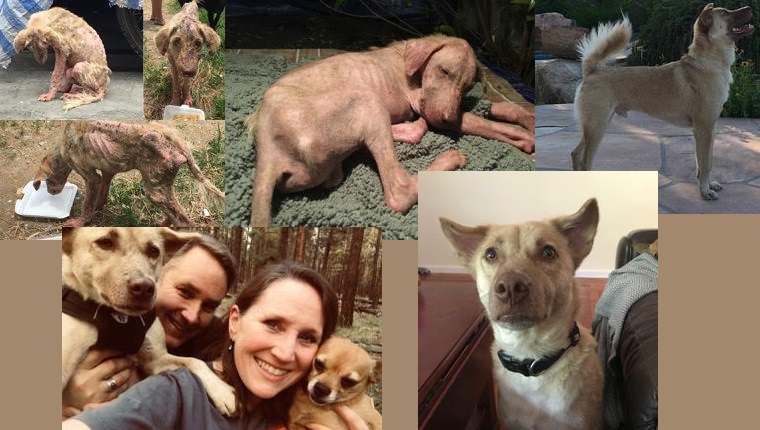
AMANDA: Not to end this on a sad note, but one part of the video I watched mentioned how you have to rescue some dogs from particularly horrible situations. Could you talk a little about that, and then maybe we could end on a happy note with one of the happiest success stories you’ve seen with your rescue.
MICHAEL: If you have 1,000 good people that care or even don’t care about dogs, you can have just one who is bad, and that can destroy everything. It’s the same everywhere, not just here.
I think that we have taken in a few dogs that were in really bad shape. One dog had had a leg cut off by a machete, but she’s fine with us now — really! They move on so quickly — unless she were to see the person who did this to her.
All the success stories are still living here, whether they’re hurt or not hurt.
There was one dog named Milo. We took him in in June 2016. At six months old, he was in such bad shape, with mange, and he was very skinny, but he was happy. We took him in and healed him up.
Six months later, I sent him over to America. He lives in Flagstaff, Arizona.
I went over there in 2019 and saw him again after three years. I actually dog-sat for him! So yeah, that was a success story, and he’s still living there, and he has a happy, nice life.
One dog was shot by a few teenagers. They shot her in the neck and spine. She was able to walk for another day, but then the bullet paralyzed her. But she is fine, now! She is paralyzed, but happy.
I mean, all the dogs who are still with us have been happy success stories.
This is my guy, Cork! Cork is paralyzed. He’s been with me since 2012.
AMANDA: What a cutie!
MICHAEL: He was run over by a motorbike when he was nine months old, but he wanted to stay here. People ask me how I cope.
I say I cope because I know they will get better.
And if they don’t, well, at least we gave them a chance. People always ask me if I get sad if they died. I do get sad — not because they died, but because they probably had a bad life before this.
Most of them are happy dogs now, and they just take it day by day. Dogs are kind of easy. They don’t dwell in the past. They wake up, see their buddies, go for a walk. It’s Christmas every day for them.
AMANDA: I love that so much! If only we could all be like that and live in the moment, right?
MICHAEL: I do try to do that! I do have to plan out some things, like getting donations, talking to people like you, but besides that, we can just take it a moment at a time. I think I’m half-dog now! *laughs*
Keep Up With TMTRD
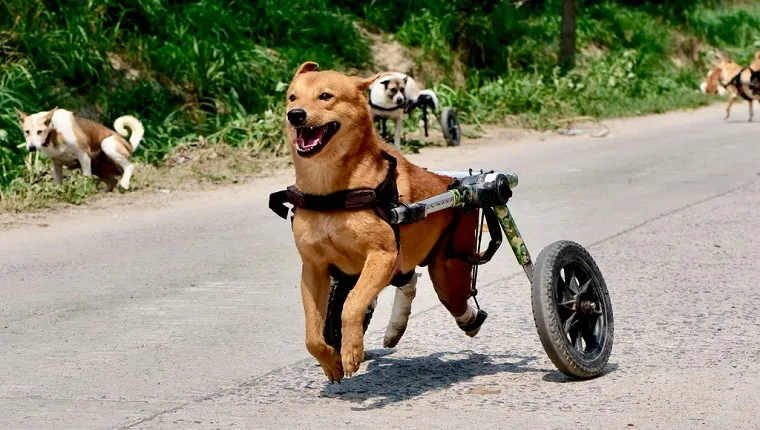
It’s been such an honor to talk to Michael and learn more about this rescue. I hope you, our readers, will love reading about him and consider supporting their work.
To learn more about The Man That Rescues Dogs, including their free healthcare clinic and how you can help, please visit their website at www.tmtrd.org.
To follow them on social media, please see their Facebook, Instagram, or YouTube pages.
Are you amazed by all the amazing work that “The Man That Rescues Dogs” does? Will you support this rescue and help get the word out? Let us know in the comments below!
